by
Dr Stephen J Nash | Oct 09, 2012
Most Australian investors equate a “balanced” portfolio with 75% equities and 25% bonds, give or take a few extra assets and variations in weightings. This article looks at how frequently such an allocation fails to generate an average return equal to the annual risk.
In this piece, we will review the return to risk ratio for two portfolios, a bond biased portfolio, and an equity biased portfolio, and we do this firstly in broad terms and then in a more detailed format.
1. Assumptions and details of analysis
We use indices to avoid the analysis being biased from the fortunes of individual security demand and supply. For bonds the UBS Australian Composite Bond Index, 0+ years is used, while the equity market performance is estimated using the All Ordinaries Accumulation Index. Since the Composite Index comprises all the various sectors in the Australian bond market (Commonwealth government, semi government bonds, supranational issuers, and corporate issuers) the results are quite reliable and stable.
In order to cover as many possible situations and scenarios, the maximum data set is used. The daily index data starts on 3 October 1989 and finishes on 27 September 2012. When we refer to the “bond” portfolio, we are referring to the portfolio that has a 75% allocation to bonds and a 25% allocation to equities, by market value. In the alternative, when we refer to the “equity” portfolio, we are referring to a portfolio that has an allocation of 75% equities, and 25% bonds.
In general, this analysis looks at what we call a ratio of return to risk, which is the ratio that places expectations of annual average return relative to the amount of variation in that average, or the annual standard deviation of return, where average annual return is divided by average annual risk. Standard deviation is a widely used statistical measure of the variation, or dispersion, which occurs around the average value, or mean. Subject to assumptions about the distribution of individual observations, various amounts of standard deviations can describe various percentages of the total observations. For example, if the observations are normally distributed, then one standard deviation either side of the average will encompass the majority of observations, around 68%, while two standard deviations will encompass around 95% of the population.
Generally, there are three ways of looking at the relationship between return and risk:
- Look at the broad categories of the risk return ratio, so (i) lower than 0, (ii) between 0 and 2, and (iii) better than 2. A return to risk ratio of lower than 0 means average return is negative for that segment of the data set. In the alternative, if the return to risk ratio is lower than 1, then investors are receiving more risk than return from a portfolio. A return to risk ratio of greater than 2 means that the portfolio is receiving twice the average return, when compared to average risk. We consider these broad categories in isolation, in section 2.1
- Compare the two alternative allocations, the bond and the equity allocations, as we do in section 2.2
- Compare the two allocations in a more detailed fashion, as we do in section 2.3
2.1 Individual broad frequencies
When we look at the ratio of return to risk, we normally would expect to receive an average return, or an investment “benefit”, that is greater than the variation in that average, or the investment “cost”, in a portfolio.
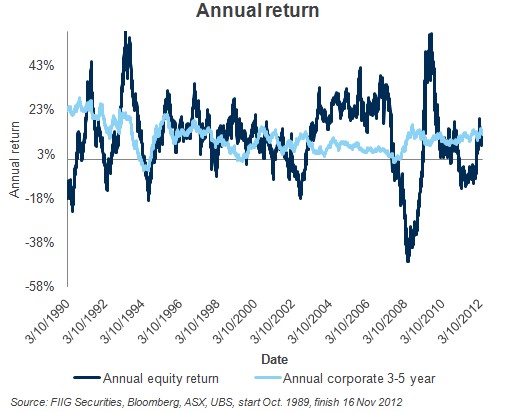
Figure 1
However, that expectation is just not met with the equity portfolio. Specifically, notice how large the frequency of the ratio, of return to risk, for the dominant equity portfolio being lower than 0 is large; around 31%, which is around the same as having a return to risk ratio of greater than 2.
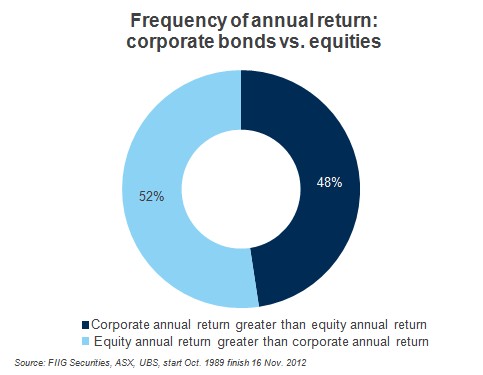
Figure 2
However, the picture brightens with the bond portfolio. In comparison the 75% bond portfolio has a much better frequency distribution, of the ratio of return to risk. Specifically, having a greater than 2 ratio of return to risk, records a 61% likelihood. Such a ratio means that the portfolio receives twice the amount of return than risk; a great situation to be in. The frequency of the return to risk ratio being lower than 0 is much lower; around 10%, which, in turn, is much less than the possibility of having a return to risk ratio of greater than two.
2.2 Comparative broad frequencies
Now, we can compare these results using the same broad categories on the same graph, as Figure 3 shows. Notice the bond allocation comes out much better, as the return-risk ratio is skewed to the right, while the equity allocation is largely flat across the categories.
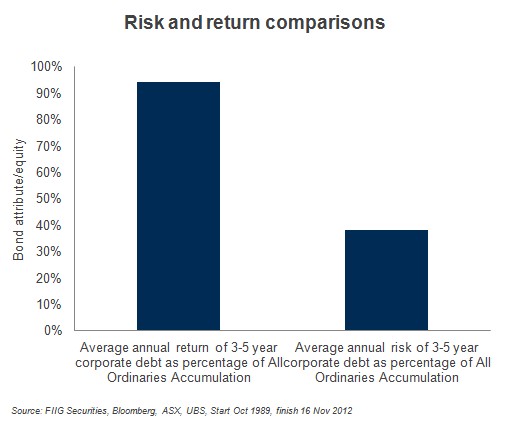
Figure 3
Now, if we take the equity portfolio results from the bond portfolio, or the dark blue in Figure 3 from the light blue, we can derive Figure 4. Notice how the bond portfolio has less frequency in the lower broad categories, and higher frequency in the best category, when compared to the equity portfolio.
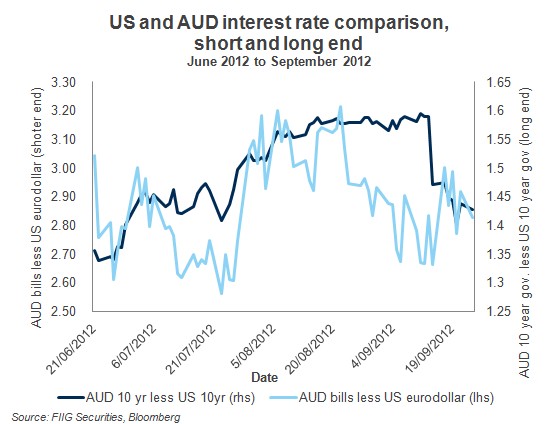
Figure 4
2.3 Detailed comparison
A much more detailed analysis of each possible level of the return to risk ratio is possible, which shows the distribution of the return-risk ratio over all possible quantitative levels of the return to risk ratio. Notice how the dark blue line, the equity portfolio, is skewed to the left, or where the negative return-risk ratios exist, while the bond portfolio, the light blue line, has the opposite skew, to the right, where the positive return-risk ratios exist.
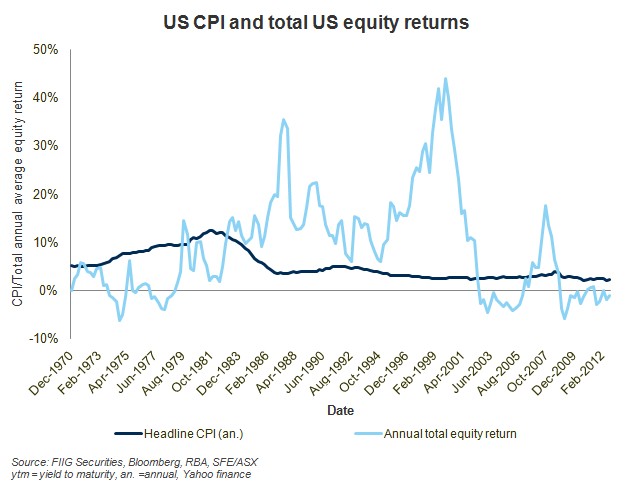
Figure 5
Now we can do as we did in the previous section and derive the difference between the two portfolios, where we take the results of the dark blue line, the equity portfolio, from the results of the light blue line, the bond portfolio. Notice how the bond portfolio beats the equity portfolio in most of the positive measures for the ratio of return to risk, as shown in Figure 6 below. On the other hand, notice how the bond portfolio avoids a lot of the negative readings, as shown on the left side of Figure 6 below.
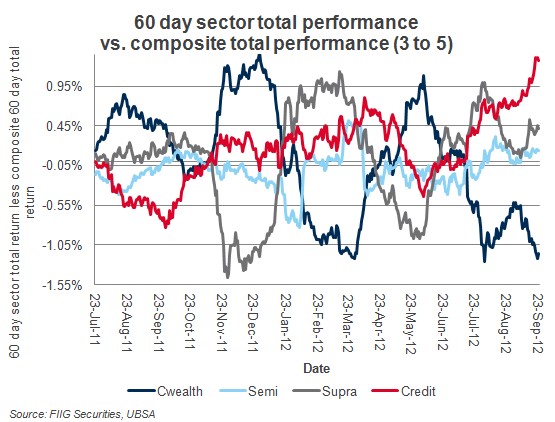
Figure 6
3. Conclusion
Doing things differently can pay off. Here, we argue that adopting the opposite of what most deem a “balanced” portfolio has significant benefits. Following the herd has led to a portfolio to incur more risk and less return; a lot more risk. We show that the equity portfolio is three times more likely to provide a ratio of return to risk that is negative, compared to the bond portfolio. Also, the bond portfolio has much better participation in the higher readings of the return to risk ratio, when compared to the equity portfolio. All this means that both risk, and return, is much more predictable, in the case of the bond portfolio, compared to the equity portfolio. Feeling good about doing what everyone else is doing, therefore, comes at a high price, as measured and discussed herein.
So doing things differently may well provide a welcome reduction in risk without a corresponding reduction in return. A higher ratio of return to risk is a better outcome for investors, and the bond portfolio, or the opposite allocation to the “balanced” portfolio, delivers much better results for investors, no matter which way you look at it.